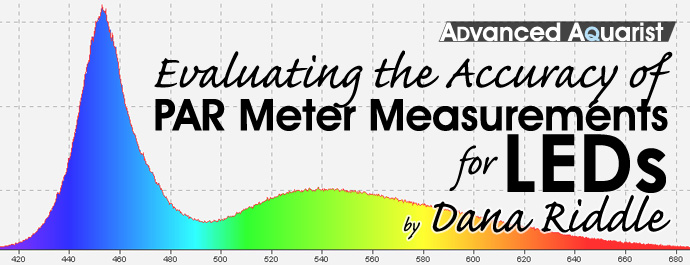
It was 2005 when I last wrote an article presenting results of a comparison between Photosynthetically Active Radiation (PAR) meters, and the lamps used during testing were metal halides of various kelvin ratings (see Riddle, 2007). In those days, the use of light-emitting diodes (LEDs) for aquaria was something discussed by only a few. Nowadays, use of metal halide lamps is much less popular and usually seen over larger aquaria or those of die-hard fans, yet, to my knowledge, there have been no updates on the utility of different brand PAR meters and their responses when judging output of LEDs.
This article will compare the responses of three quantum meters when measuring LED light output. Specifically, these are meters manufactured by Apogee Instruments™ (model QMSW-SS; Logan, Utah), Li-Cor Biosciences™ (LI-1400 datalogger and LI-189 sensor; Lincoln, Nebraska) and Spectrum Technologies™ (FieldScout; Plainfield, Illinois).
Product Details
Li-Cor LI-1400 Quantum Meter and LI-189 Sensor Li-Cor Biosciences (Lincoln, Nebraska, USA) is noted for quality instruments, and their meter/sensor combinations have gained wide acceptance within the scientific community. Quality comes at a price (the referenced combination currently costs more than $3,000). The sensor construction is an intricate one – see Figure 1. In addition, the sensor is relatively large and the cord exits the bottom. These facts restrict its use to larger aquaria.
Apogee Quantum Meter Apogee Instruments (Logan, Utah, USA) manufactures entry-level PAR meters and sensors, and many hobbyists have found favor with them due to their affordability. The sensor is relatively small and its cord exits the side making it ideal for use in tight quarters (such as aquaria).
FieldScout Quantum Meter Spectrum Technologies (Plainfield, Illinois, USA) manufacturers a number of products aimed at the agricultural/horticultural markets. Although the meter tested here is the FieldScout Light Meter, the sensors are interchangeable with other Spectrum products (such as their wonderful WatchDog datalogger). The sensor tested here was custom-built for my lab for use when testing artificial light sources. Spectrum does not recommend their quantum sensor for use with LEDs but I wondered just how much of an error there actually is, hence I have included it in this review.
In all fairness, we’re comparing an expensive instrument (the Li-Cor setup costing over $3,000) to relatively inexpensive ($300-$400 or so) units. A calibrated light source would be needed to accurately judge the responses of all three meters. This luxury was not available for this review, hence the Li-Cor meter – based on the advertised responses of all three meters – will be considered ‘correct’.
There are several things that can affect a quantum meter’s reading, these include:
- Spectral sensitivity of the sensor
- Spectral quality of the light
- Sensor Cosine Correction
- Sensor Construction (2 pi or 4 pi)
- Testing medium (air, water, etc.)
- Condition of the sensor (physical damage, age – ‘fogging’ of optical components, cleanliness)
- Sensor/meter calibration
- Temperature
- Light source used for calibration by the manufacturer
These terms will be used throughout this article:
Glossary Actinity Error: A perfect PAR sensor would be equally responsive to all wavelengths of light between 400nm and 700nm. In practice, this is not possible and response difference between a real sensor and a theoretical one is called the actinity error. Various sensors over- or under-report blue wavelengths while red wavelengths are often under-reported.
Correlated Color Temperature (CCT): is a specification of the color appearance of the light emitted by a lamp relating its color to the color of light from a reference source (a blackbody) when heated to a particular temperature, measured in degrees Kelvin (K). The CCT rating for a lamp is a general “warmth” or “coolness” measure of its appearance. However, opposite to the temperature scale, lamps with a CCT rating below 3,200 K are usually considered “warm” sources, while those with a CCT above 4,000 K are usually considered “cool” in appearance.
Cosine Correction: A light sensor should be able to accurately measure light at angles to ~90 of normal incidence (0), and a cosine-corrector allows this. Two cosine-correction types exist – one type is a hemispherical plastic diffuser dome (used by Apogee and Spectrum Technologies), while the other is a plastic cylinder (that should rise slightly above its housing in order to properly collect light, which the Li-Cor sensor does).
All sensors are advertised to be cosine-corrected, meaning their response will be the same to a beam of light, regardless of that beam’s angle of incidence to the sensor (up to a point. Li-Cor advertises their sensor to be correct for light falling at an 80 angle from normal while Apogee states their sensor is ±1% at a 45 angle (from zenith) and ±5% at a 75 degree angle from zenith).
Full Width Half Maximum (FWHM): This is an important concept in light measurement. It is simple and easily defined. While the spectral width of the light source could extend for some distance, the maximum is easily determined as is the half-maximum. FWHM is generally used to define peaks and half-maxima of relatively narrow bandwidths (such as LEDs and other ‘specialty’ cases such as fluorescence). See Figure 2.

Figure 2. Full Width Half Maximum (FWHM) is an important concept, especially with narrow bandwidth light sources such as LEDs. In this case, the peak is at 500nm with a FWHM of ~50nm (475-525nm).
FWHM is not used for broadband light sources (such as sunlight and most artificial light sources). Let’s take an example of why FWHM is important. See Figure 14 – it is the spectral characteristics of a combination of blue and white LEDs. This example would share the FWHM characteristics of a blue LED while ignoring the full spectrum characteristics.
Immersion Effect: Reflection of light within a sensor immersed in water is less (relative to a measurement made in air) and results in a greater loss of light. This is due to the refractive indices of plastic and air or water. Hence, more expensive devices (such as the Li-Cor) allow for an ‘air’ or ‘water’ calibration to overcome the immersion effect. The Apogee and Spectrum Technologies meters do not offer this option.
Integrating Sphere: A device used in measuring light and especially useful when determining flux or spectra of LEDs. Basically, it is a hollow sphere with a diffusive interior coating. Two ports (one for the LED and the other for a light sensor) are at a 90 angle to one another.
Lambertian Reflectance: Diffuse reflectance is that which appears to be of the same brightness regardless of the observer’s viewing angle. Labsphere’s Spectralon (a fluoropolymer) offers an almost ideal Lambertian surface. Barium sulfate is a less expensive – but less Lambertian – material.
Light-emitting Diode (LED): A light emitting device consisting of a positive/negative junction where a small amount of electrical current excites metallic compounds doped on a small ‘cup’.
Photosynthetically Active Radiation (PAR): Light energy powers photosynthesis. This light’s bandwidth has been standardized to that electromagnetic energy between 400 and 700nm (violet to red) per area unit (often 1 square meter) per time unit (usually 1 second). PAR is reported as Photosynthetic Photon Flux Density (PPFD) in units of micromole photons per square meter per second (µmol·m²·sec).
Reflectance: The ratio of the total amount of radiation, as of light, reflected by a surface to the total amount of radiation incident on the surface.
Two pi Sensor; Four pi Sensor: Sensors that collect light only from the direction the sensor is pointed is called 2 pi. A scalar sensor collects light from all directions. A 4 pi scalar sensor resembles an incandescent light bulb. See Figure 3.

Figure 3. Two types of Li-Cor PAR sensors. A 2-pi sensor is on the left (like the one used in this report). A 4-pi sensor is to the right.
Spectral Responses of Three PAR Sensors
Understanding the spectral sensitivities of different PAR sensors is helpful in understanding how accurate measurements will be, especially when dealing with narrow bandwidth light sources, such as LEDs. For our purposes, there are two types of sensors – silicon and gallium arsenide phosphide (GaAsP). The Li-Cor sensor is the silicon type, while the Apogee and FieldScout sensors appear to be made of gallium arsenide phosphide. Figure 4 shows the spectral sensitivity of the Apogee meter, Figure 5 the FieldScout’s, and Figure 6 that of the Li-Cor. Unfortunately, Spectrum Technologies does not provide the relative ideal response of their sensor and we therefore must make some assumptions about the actinity errors. Figure 7 is a side-by-side comparison of the Apogee and Li-Cor responses.
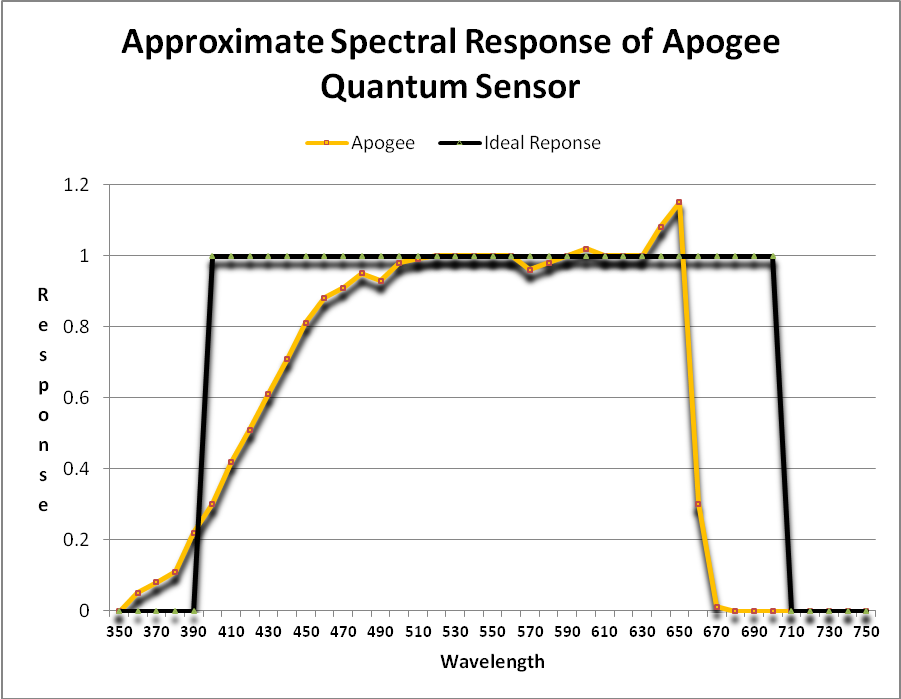
Figure 4. The Apogee quantum sensor underestimates violet/blue and red wavelengths. Apogee advertises their sensor is responsive to light wavelengths in the range of 409nm to 659nm. After Apogee Instruments’ website.
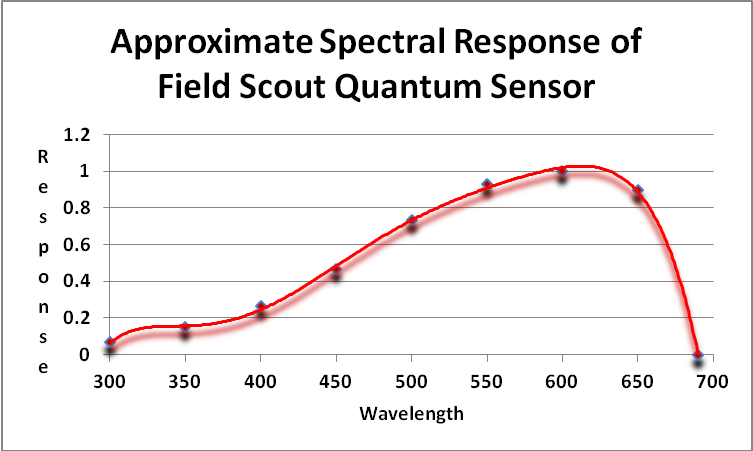
Figure 5. Response of the Field Scout Quantum sensor – it appears to be an unfiltered gallium arsenide phosphide (GaAsP)-based photo-sensor. No ideal response information is available. After data on Spectrum Instruments’ website.
The Apogee meter apparently uses a gallium arsenide phosphide (GaAsP) based sensor with a lens/filter in order to slightly correct the sensor’s response. However, it is generally agreed that this type of sensor underestimates violet/blue light (400-500nm) and red wavelengths above 650nm.
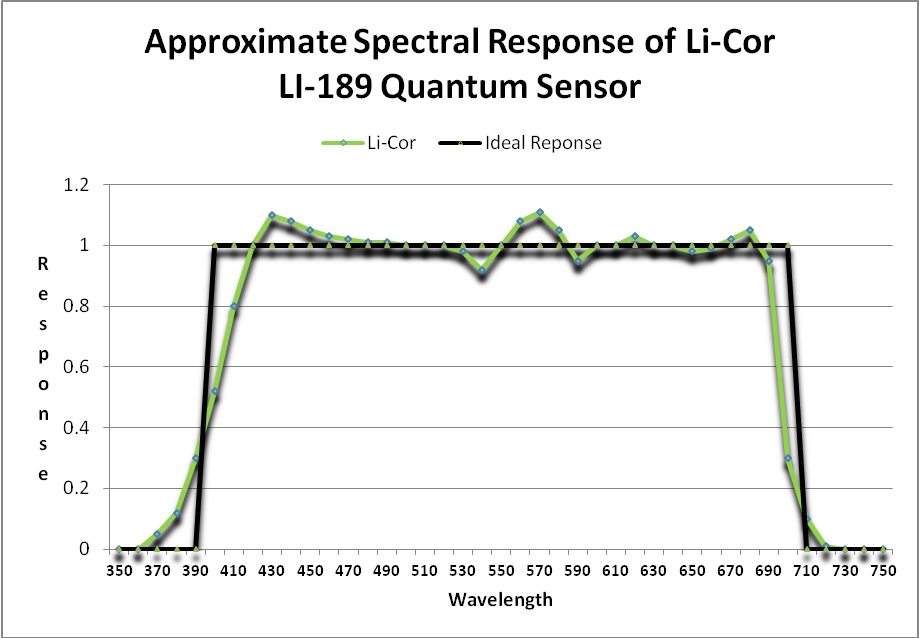
Figure 6. The Li-Cor quantum sensor underestimates violet (410-420nm) slightly, and red light (690-700nm). This sensor’s response is the gold standard in botany/phycology research fields. After data on the Li-Cor website.

Figure 7. A comparison of the Apogee and Li-Cor sensors’ responses. The Spectrum meter is not included due to little available information on its spectral response in relation to ideal response.
Effects of Temperature
Apogee’s calibrates their quantum sensors at 68F (20C). It reads 0.6 percent high at 50F (10C) and 0.8 percent low at 86F (30C) – see Figure 8. Li-Cor states a change of ± 0.15% per °C (maximum).
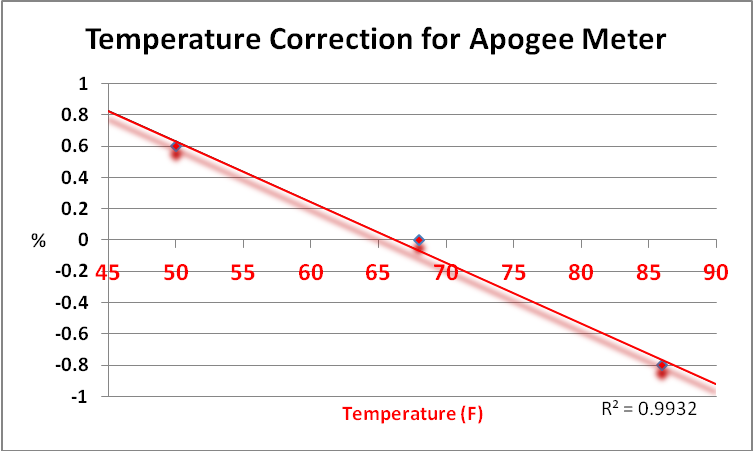
Figure 8. Effect of temperature on Apogee PAR measurements. Calibration is done at 68F (therefore, ‘zero’ error). At the temperature of most tropical reef aquaria, the reading would be 0.4-0.5% low.
Relative Humidity
When making sunlight measurements, the amount of water vapor (humidity) in the atmosphere can cause lower than expected readings. See here for details:
http://clearskycalculator.com/model_accuracyPPF.htm#RH
Note that all reported measurements were made in the air and the impact of the ultimate humidity – water – will impact meters’ responses.
‘Sun’ and ‘Electric’ Measurements
In the models tested here, Apogee and Spectrum meters offer two measurement modes to overcome deficiencies in the spectral responses of their sensors. Testing revealed that, on average, there is a difference of about 10% between the two modes. However, spectral quality decides which mode is best for a given light source.
Our testing begins with:
Response of Meters to Sunlight
Figures 9 and 10 show the meters’ responses to broadband light energy (sunlight, during an overcast morning) and the spectral quality of that light, respectively. As we can see, all meters do a reasonable job of reporting PPFD.
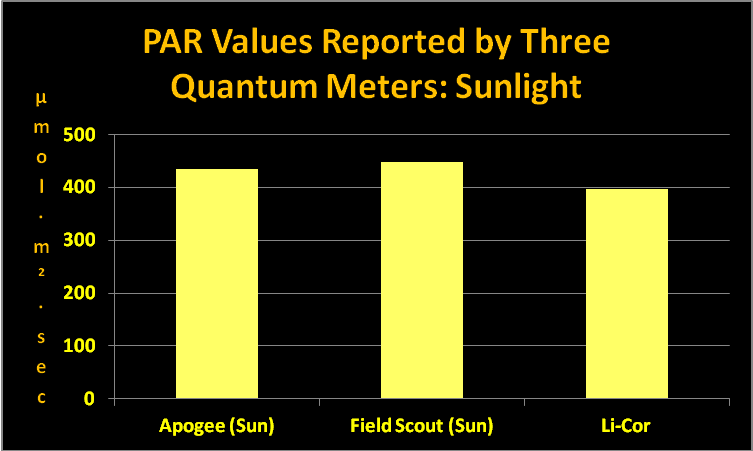
Figure 9. A comparison of the Apogee, FieldScout, and Li-Cor sensors’ responses to the light field on a cloudy Hawaiian morning. See spectral characteristics in Figure 10. At this intensity, the Apogee reads ~10% high, and the Field Scout reads ~13% when compared to the Li-Cor measurement.
Response of Meters to Individual LEDs
As we have seen, each of the PAR meters have done a reasonable job of reporting PAR values of sunlight, even though their sensors’ spectral sensitivities vary dramatically. Results of LED testing will now be presented.
Blue LEDs
Blue LEDs are ubiquitous in lighting designed for reef aquaria and are often combined with LEDs emitting ‘white’ light (‘white’ LEDs are blue LEDs to which a phosphor has been added. This phosphor absorbs some of the blue light and fluoresces it in a broad spectrum). Two blue LEDs were examined. See Figures 11 and 12 (notice the differences in the FWHM of the two).

Figure 12. Acan Lighting’s blue LED spectral quality (peak emission at 454nm; FWHM=443-467nm). Analysis of Corrected Color Temperature (CCT) revealed these LEDs were at least 50,000 K (measurements bounced between 50,000 and , or ‘off the scale’).
The following Figure (13) shows the PAR measurements of the Acan blue LED.
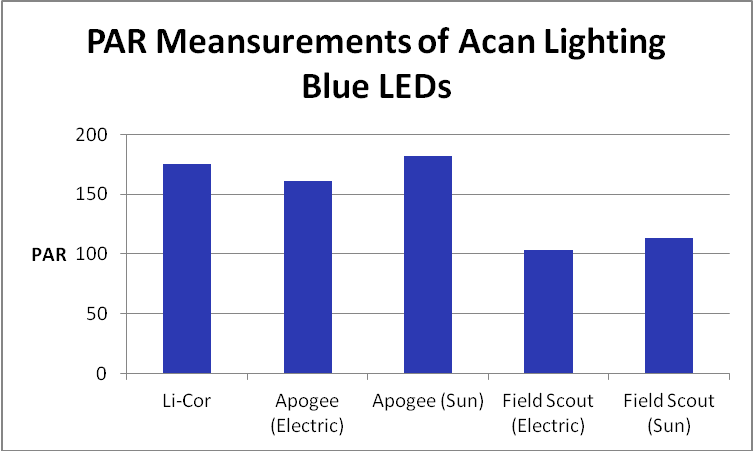
Figure 13. Not surprisingly, there are significant differences among the reading of the 3 PAR meters. These are not maximum PAR values.
Blue/White LED Combination
This combination of LEDs is perhaps the most popular among reef hobbyists, although the ratio of white to blue varies. Figure 14 shows the spectral characteristics of Acan Lighting’s LED luminaire (ratio of 2 cool white to 1 ‘royal’ blue).
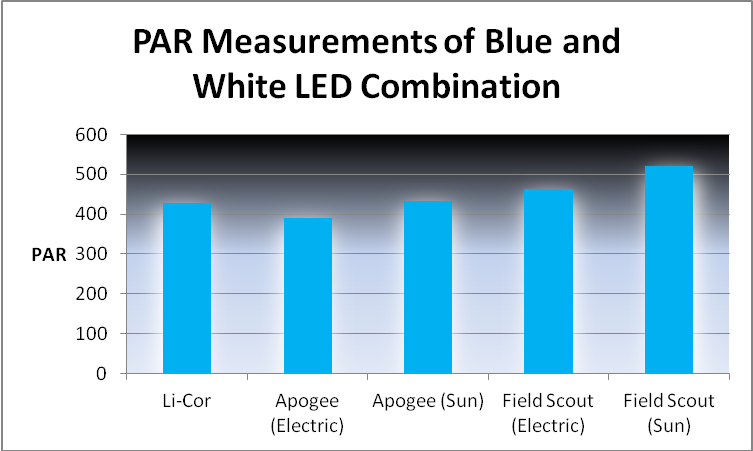
Figure 15. PAR measurements of Acan Lighting’s blue/white combination LEDs. These are not maximum PAR values – that was not the goal of the experiment.
White LEDs
When comparing the spectra of blue and white LEDs, it is easy to see the effects of the phosphors added to a blue LED (these phosphors are the same as those used in broad spectrum fluorescent lamps). White LEDs are often used in combination with ‘pure’ blue LEDs to mimic the blueness of deeper oceanic waters. See Figure 16.

Figure 16. Acan Lighting’s white LED spectral quality. Correlated color temperature (CCT) of these LEDs measured 7,300 K which is generally considered to be ‘cool white’.
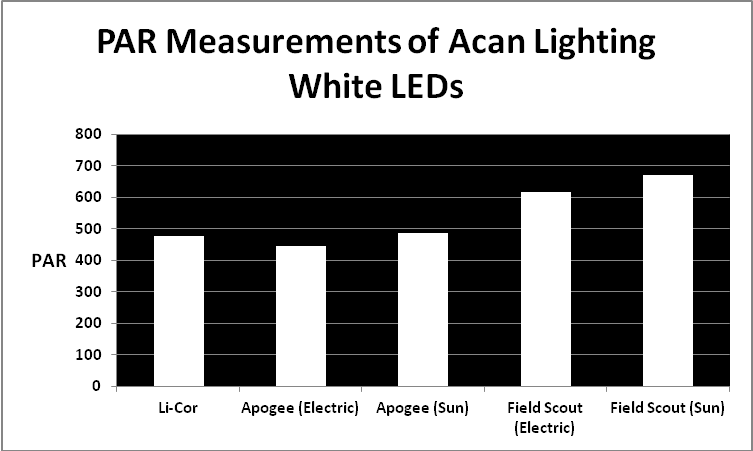
Figure 17. PAR values of Acan Lighting’s 7,300 K ‘cool white’ LEDs. No attempt was made to ascertain maximum PAR levels.
Cyan (or Aqua) LED
Those manufacturers specializing in reef aquaria lighting have recently begun adding variously colored LEDs to their luminaires (interestingly, the first commercially successful LED luminaire, made by PFO Lighting) used green LEDs in addition to blue and white ones). Use of cyan LEDs has a basis when we examined zooxanthellae photo-pigments. Chlorophyll a is sometimes bound with another photo-pigment – peridinin. This complex absorbs light into the green portion of the spectrum and makes it available for photosynthesis. See Figures 18 and 19 for a spectral characteristics and PAR measurements of a cyan LED, respectively.
Green LED
Many of the comments made about the cyan LEDs would apply to the green LED examined here. The chlorophyll a/peridinin complex can absorb the light emitted by this LED. See Figures 20 and 21.
Yellow LED
Yellow light is only weakly absorbed by zooxanthellae photo-pigments; however, there is some evidence that yellow light plays a part in intensifying the apparent fluorescence of some orange/red coral pigments. See Figures 22 and 23 for results of testing.

Figure 22. Spectral characteristics of the yellow LED with peak output of 595nm and a FWHM of ~587-603nm.
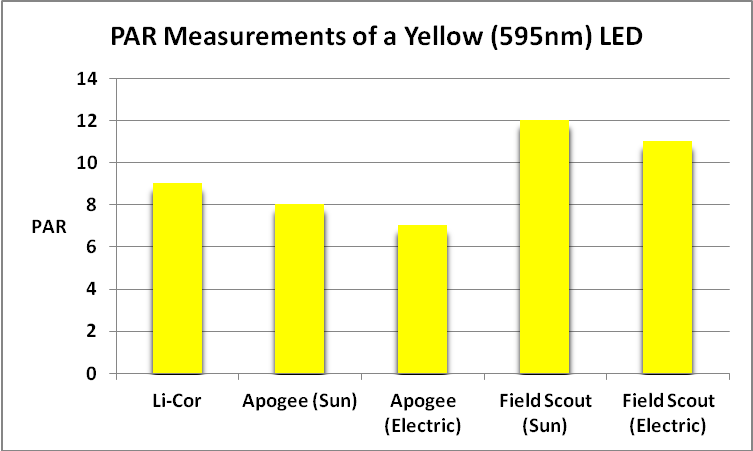
Figure 23. PAR values of a yellow LED with a peak emission of 595nm. Taken within an integrating sphere.
Red LED
Of all the LEDs examined here, those emitting red light are the most controversial. Very little red light is found at depth on natural reefs and it would seem that use of white LEDs (emitting some red light) would satisfy the visual requirements of the hobbyist while supplying more than enough red for photosynthesis. See Riddle, 2003 for effects of too much red light. I’m presently working on the assumption that if a lot of red light is harmful to zooxanthellae, then a lesser amount is proportionally harmful. I am just beginning a project to investigate red light’s impact. This will be a part of my presentation at the 2103 MACNA in Florida (www.masna.org).
See Figures 24 and 25.
This completes our observations and analyses of PAR meters and LEDs. Now for our conclusions.
Conclusion and Recommendation
I decided to write this article after hearing anecdotal comments such as ‘PAR meters are useless for measuring LED output’ and ‘Corals don’t survive long-term under LEDs’. The latter has not been my experience, but I really had no idea about the former statement. The concept for this article seemed valid enough and I suspected the article could be written in short order. I had the meters and the LEDs and making the measurements could be made quickly – or so I thought. After writing almost 300 articles for hobbyist-related publications over the course of over 25 years, one might think I would have a good handle on the complexity of a project. In this case, I thought I could research and write the article in 2 or 3 weeks. As it turned out, this work required months of research, construction, measurement, and analyses. The results are complex. To reiterate, we’re comparing two relatively inexpensive meters against one costing roughly 10x as much. When measuring sunlight, the Apogee and Spectrum Technologies meters report PAR values that compare favorably to those of the Li-Cor. Additionally, Spectrum Technologies states on their website that their sensor is not useful in making measurements of LEDs (a bit of an overstatement as we shall see).
This product evaluation took on added complexity when we consider two of the meters offer two measurement modes – in essence, we are comparing 5 meters, not three. The Apogee and Field Scout meters offer the option of two measuring modes (‘Sun’ and ‘Electric’). This is done in order to offset limitations of the spectral sensitivity of their sensors. The more expensive Li-Cor sensor and meter has no reason to offer this option due to the superior spectral response.
Interestingly, the difference in ‘Sun’ and ‘Electric’ measurement modes is almost always about 10% (suggesting the difference is simply the result of a preset electronic correction). However, this correction cannot overcome the ability of the sensor to ‘see’ light. Therefore, Table 1 is offered for those wanting to measure narrow bandwidth light sources such as LEDs.
| Apogee | Field Scout | ||
|---|---|---|---|---|
| LED | Sun | Electric | Sun | Electric |
| Blue (450nm) | X | Low | X (Low) | Low |
| Blue/White Combo | X (Low) | Low | High | X (High) |
| White (7,300 K) | X | Low | High | X (High) |
| Cyan (505nm) | High | X (High) | High | X (High) |
| Green (517nm) | High | X (High) | High | X (High) |
| Yellow (595nm) | X (Low) | Low | High | X (High) |
| Red (647nm) | X (Low) | Low | High | X (High) |
| Sunlight (Mostly Sunny)* | High | X (High) | High | X (High) |
| *Sky Conditions and Sensor Response: As even the most casual observer knows, sky conditions can drastically alter its apparent color composition. The most obvious examples are the yellow ‘morning’ and orange ‘sunset’ colors. However, more subtle effects are in play during the day. ‘Cloudy’ refers to the blue sky and sun being hidden completely by opaque clouds. ‘Sunny’ conditions exist when no clouds are present. A ‘mostly sunny’ sky is obscured by no more than 2/8ths opaque clouds. ‘Partly sunny’ and ‘mostly cloudy’ means 3/8 to 5/8ths and 6/8 to 7/8ths opaque clouds, respectively. The term ‘clear’ (as opposed to sunny, naturally enough) is used for nighttime observations. ‘Fair’ is not a useful meteorological term and should be avoided. | ||||
1 The impact of volcanic smoke (vog) on the meters’ performance is unknown. Although the measurements were made when conditions were considered to be ‘mostly sunny’, there is a certain haziness to the sky. Vog is known to absorb some ultraviolet radiation. In addition, there is a considerable amount of seawater aerosols in the air.
Simply using the manufacturer’s sensor spectra response chart can lead to incorrect conclusions. There were some surprises. It seems to be current wisdom that the Apogee meter under-reports blue light, yet the results of testing showed the meter performed well when in ‘sun’ measurement mode (while the electric mode read low). Similarly, the Apogee did very well in ‘sun’ mode when analyzing the output of 7,300 K white LEDs. In addition, the Apogee and FieldScout meters repeatedly performed best when measuring sunlight when in the ‘electric’ setting.
Based on these observations, inexpensive PAR meter have some utility for measuring light produced by LEDs.
Lux to PAR Conversion Factors
If you have a lux meter, it is possible to convert lux measurements to PAR values. Use these results with some caution – in most cases it would be safe to assume the results will be low.
- Divide blue (450nm) LED Lux by 69
- Divide white (7,300 K) LED Lux by 45
- Divide blue (450nm)/white (7,300 K) combination LED (2:1 white/blue ratio) Lux by 67
Technical Notes
Spectral analyses were performed by Ocean Optics USB2000™ fiber optic spectrometer and SpectraSuite™ software (Ocean Optics, Dunedin, Florida). It took some doing to design and build a workable integrating sphere from scratch (on the order of weeks). Original prototypes were made of papier mâché and were large (6-inch, or ~150mm) diameter, then reduced to 3-inch (76mm). These proved to be too large and did not sufficiently concentrate light. Ultimately, ping pong (table tennis) balls were used. Their exterior were painted white and the interior of the hollow spheres were painted matte white and then coated with barium sulfate (ACS grade) in order to create a surface with good diffuse spectral reflectance characteristics. Barium sulfate was mixed with un-tinted white latex paint (90:10 weight: weight). Two 1/2″ (12mm) holes were drilled into the sphere at a 90 angle. An interior baffle was placed adjacent to the sensor port to prevent light from falling directly upon it.
Barium sulfate is known to offer good reflectance at ~425 – 700nm. To check this, the barium coating was compared to a diffuse reflectance standard (Labsphere Spectralon WS-1-SL, a fluoropolymer offering a highly Lambertian surface with reflectivity of 99% at 400-1,500nm). See Figure 26 for the reflectance of the barium sulfate coating.

Figure 26. Reflectance of the integrating sphere’s barium sulfate coating. Reflectance is very good for those spectral sources examined in this article. Ideally, the line should be horizontally flat. This figure shows that violet/blue light is reflected a little less well than other wavelengths.
Figure 27 shows the integrating sphere.
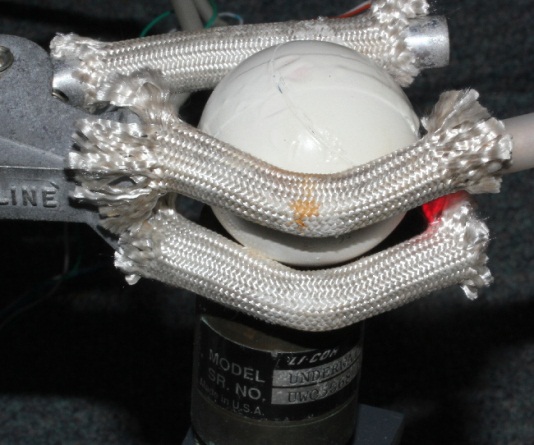
Figure 27. The ‘table tennis ball’ integrating sphere. Light from the LED enters from the right (a slight red glow of a red LED can be seen). Light is reflected by the internal barium sulfate surface and is collected at a 90 angle by a PAR sensor (in this case, one manufactured by Li-Cor Biosciences).
The integrating sphere would not collect enough light in some cases. To overcome this problem, measurements were made of the high intensity output of a LED luminaire manufactured for aquarium use (Acan Lighting, model 600-18B, Commack, NY). See Figure 28.
Determination of Correlated Color Temperature (CCT) was determined with an Ocean Optics USB 2000 spectrometer and SpectraSuite software. In order to do so, the spectrometer’s measurements must be calibrated to a known source. To this end, an Ocean Optics’ LS-1-Cal tungsten halogen NIST-traceable light source was used. This light source had little use on it and total hours fell well below the cutoff of 50 hours (when re-calibration is required). Settings of the software included a setting for ’emissive’ color (that emitted by a light source such as a LED) and 2 Observer (photopic, daylight observer).
Lux measurements were made using a Gossen Luna Pro lux meter (Gossen Foto-und Lichtmesstechnik GmbH, Nürnberg, Germany).
Calibration
Apogee recommends calibration of their meters ever 3 years, while Li-Cor recommends every 2 years. The Apogee meter has not been calibrated since purchase. The Li-Cor LI-1400 data logger is new and its sensor was rebuilt about 5 years ago.
To check if your PAR meter needs re-calibration, see this site:
http://clearskycalculator.com/longitudeTZ.htm
Note: This calculator works if the sky is truly clear. It did not perform well here in Hawaii due to the amount of ‘vog’ from the continuing volcanic eruption.
References
- Kirk, J.T.O., 2000. Light and Photosynthesis in Aquatic Ecosystems. Cambridge University Press, Cambridge, United Kingdom. 509pp.
- Riddle, D., 2005. Product Review: A Comparison of Two Quantum Meters- Li-Cor v. Apogee. http://www.advancedaquarist.com/2005/7/review
- Riddle, D., 2003. Effects of narrow bandwidth light sources on coral host and zooxanthellae pigments. http://www.advancedaquarist.com/2003/11/aafeature

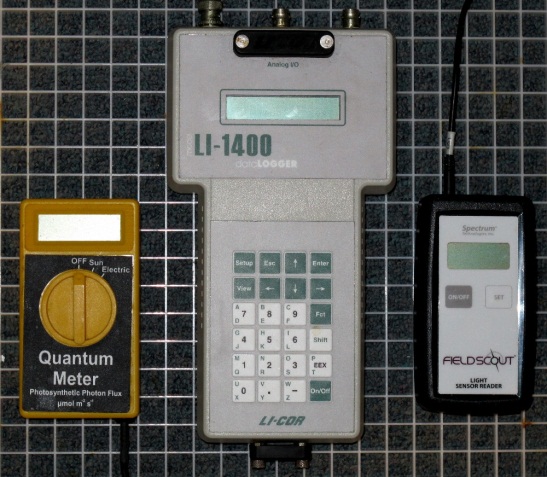
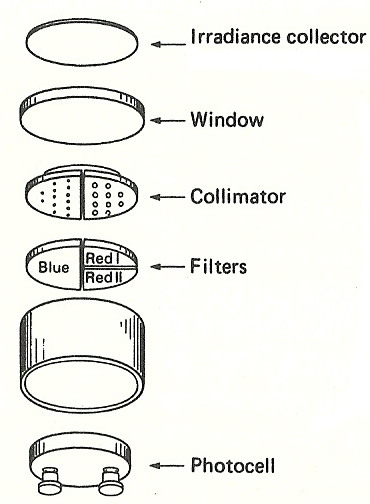




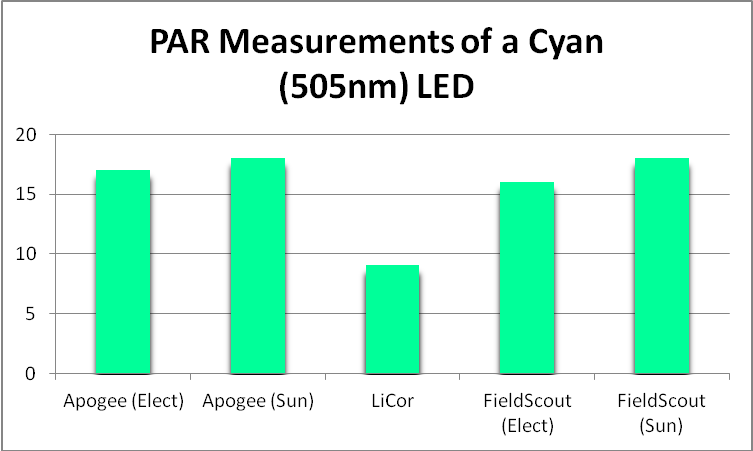

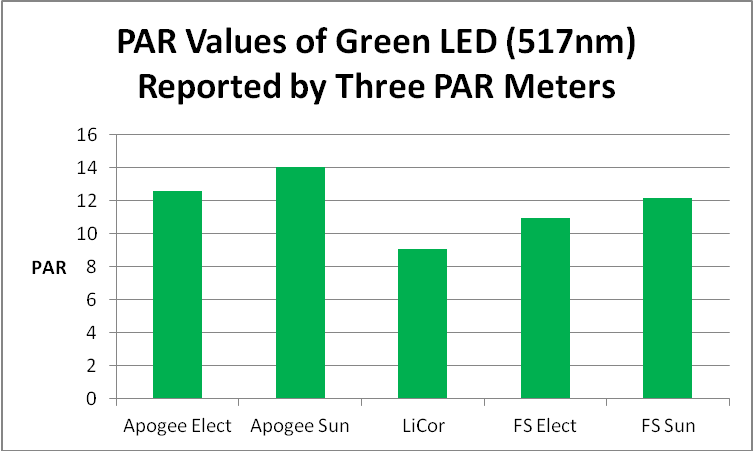

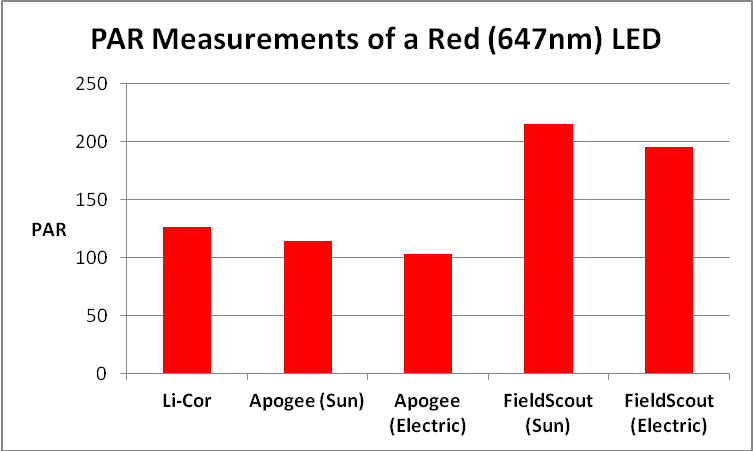


0 Comments